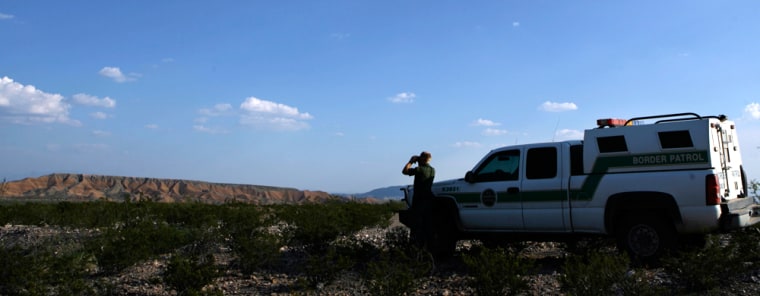Despite efforts to add Border Patrol agents to areas where immigrant traffic is high and drug violence is flaring, officers assigned to the 2,000-mile boundary with Mexico are bunched up near the California coast. And some critics see politics at play.
An Associated Press analysis of Border Patrol staffing shows that the San Diego sector, with the shortest section of border and fences covering half the boundary, has four times the number of agents per mile that West Texas does and three times as many as most of Arizona.
That is the case even though the Tucson sector in Arizona has been the busiest spot for illegal crossings for years and El Paso sits next to a Mexican city that has seen a surge in drug-cartel violence so severe that Mexicans are pleading for asylum in the U.S.
"I think it makes us less safe," Sen. John Cornyn, R-Texas, said of the way agents are posted along the border.
Border Patrol officials defend the staffing levels, saying San Diego's transportation routes and year-round balmy weather make it an attractive spot for smugglers.
Others suggest, however, that members of Congress who most embrace the agency's push are rewarded with more agents.
Enforcement sector
Borderwide, staffing has increased dramatically in the past five years as political pressure to prevent illegal immigration has mounted. On the southern border, there are roughly 15,000 agents, up from 9,500 in 2004.
And while the most dramatic growth has occurred near the Arizona-California line and around El Paso, San Diego's short section of border has, by far, the most agents per mile at 37. That compares with 11 for most of Arizona and nine for the Rio Grande Valley and West Texas, based on head counts given to the AP in July.
The 60-mile San Diego sector is at the southern end of a county with roughly 3 million people. It has two major northbound highways and easy access to food, water and communication — all of which make it inviting to smugglers and illegal immigrants.
But the sector is already heavily reinforced: Two-thirds of the border is blocked by fences or vehicle barriers. The most populous part of the boundary has nearly 10 miles of double-layer fences with stadium lights.
Busiest and deadliest
The border in Arizona and Texas is more wide open and more rural in many places, which can make it harder to guard. It also includes major interstates and sizable population centers where recent arrivals can easily blend in. The Rio Grande forms the border in Texas, but in many places it is possible to swim, wade or float across it.
Arizona has long been the busiest and deadliest section of the border, recording hundreds of deaths in recent years among immigrants who fell victim to the rocky terrain and the fierce desert heat and cold.
Nearly half the apprehensions of illegal immigrants along the Mexican border are made in the Tucson sector, but those numbers are a poor indicator of effectiveness because research indicates that people trying to sneak across get caught less than half the time, said Wayne Cornelius, a professor at the University of California at San Diego.
'The agents are needed'
Border communities in Texas have seen a frightening rise in drug violence spilling across the border, with assassinations and kidnappings in the United States.
Jaime Castillo, a Border Patrol spokesman in Washington, said the allocation of agents is "intelligence-driven" and done according to requests from the individual sectors.
"They're the best experts to predict what they're going to need to manage their area of operation," he said.
Mark Endicott, a spokesman for Border Patrol in San Diego, said the sprawling city's close proximity to the border, favorable climate and many transportation options make the area unique. He declined to discuss whether San Diego's needs outweigh those of other sectors but said, "As far as the activity going on here in San Diego, the agents are needed."
Observers say, however, politics plays a role in how agents are allocated.
"In many cases, they're very political," said T.J. Bonner, president of the agents union. "Congress giveth and taketh away, so you can't just thumb your nose at Congress and say, 'We're going to make these decisions based only on our enforcement needs.'"
San Diego is represented by Rep. Duncan Hunter, a Republican who has been among the most outspoken proponents of increased border security and fences. But a spokesman said the congressman has not pushed for more agents for San Diego.
"It's nothing we've done personally in this office," said Hunter spokesman Joe Kasper.
Texas leaders, under pressure from border communities with close ties to Mexico, have pushed Customs and Border Protection to collaborate more with communities affected by the fence planned along the border and to make sure systems for those entering legally run smoothly — the kind of cajoling that has sometimes put them at odds with the agency.
Cornyn said he has asked the agency how it assigns agents.
"They say they have a formula, but I'm not convinced or persuaded that this is altogether a rational distribution of resources. There's a certain amount of whoever screams and yells gets taken care of first," the senator said.
Cornelius, the university researcher, said politics probably do play a part in staffing. The entire GOP congressional delegation from San Diego "would have screamed bloody murder if the Border Patrol had reduced San Diego sector staffing levels appreciably," he said.
